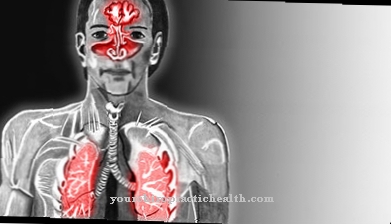The Legionnaires, which are also called Legionnaires' disease known is a severe variation of pneumonia. Legionnaires' disease is caused by a bacterium belonging to the sub-genus Legionella.
What is Legionnaires' Disease?
.jpg)
© designua– stock.adobe.com
In the Legionnaires' disease it is a serious infection in the lungs caused by the Legionella pneumophila bacterium.
The symptoms are similar to those of pneumonia and are characterized by a high fever, difficulty breathing and coughing. Treatment with antibiotics is required. It occurs worldwide in all seasons, but is particularly common in summer and autumn.
It is usually only recognized at a late stage, as it can easily be confused with classic pneumonia. In some countries around the world, the disease is notifiable. It is estimated that around six percent of all pneumonia is caused by the Legionella pneumophila bacterium. Pontiac fever is a weak variant of Legionnaires' disease.
causes
The Legionnaires' disease is a bacterial infection with Legionella pneumophila. These bacteria prefer fresh water, which has a temperature between 20 ° C and 55 ° C. If the temperature exceeds 60 ° C, the germs die.
For an infection with Legionella pneumophila, the germ must be inhaled and reach the lungs through the nose or mouth. Possible sources of infection are showers, whirlpools, air conditioning systems, inhalers and humidifiers.
In this context, it should be mentioned that the Legionella pneumophila bacterium can usually spread in the water pipes if the pipes are hardly used. If the warm water is in the water pipe for a long time, it offers an ideal medium for the germs to spread. Legionnaires' disease can spread even in German gyms if the showers have not been used for a long time during the summer holidays.
Direct transmission of the pathogen from an infected person to a healthy person is unknown. Once in the lungs, the germs multiply in the monocytes, which are a special form of white blood cells. It can take up to ten days for Legionnaires' disease to break out.
Symptoms, ailments & signs
Legionnaires' disease can cause very different symptoms. This depends on the amount and type of Legionella and the other condition of the person concerned. Immunocompromised people, children and the elderly are generally more susceptible to the symptoms of Legionnaires' disease. In any case, the symptoms can be classified as threatening but easily treatable.
After a short incubation period of around two to ten days, the disease develops suddenly and severely. The symptoms can vary widely, but are usually reminiscent of the flu. There is a very high fever, sometimes over 40 degrees, chills, muscle pain and general malaise. There is also pain or an uncomfortable feeling in the chest area. Signs of the occurring lung infection are the dry cough] and the pain.
In the further course there is a cough with sputum, whereby blood can also be admixed here. The pneumonia expands accordingly, causing shortness of breath, circulatory problems, nausea and vomiting. In addition, the physical strain can lead to neurological deficits (temporarily stepping away, movement problems, etc.).
The older and weaker the person is, the more serious the symptoms. If treatment is not started, legionnaires' disease is also classified as life-threatening.
Diagnosis & course
The diagnosis for Legionnaires' disease takes place through a detection of the pathogen by means of a urine sample. The urine is analyzed for certain proteins that are only present in the event of a Legionella infection. A sample from the lungs or throat can also provide information about an infection.
If the diagnosis is made early, the disease will take an unproblematic course. If it is not recognized and left untreated, there is a 20% chance that it can be fatal in people with immunodeficiency and the elderly. If the bacteria only triggered the Pontiac fever, those affected recover within five days even without medical attention.
If the Legionnaires' disease is over, there is no immunity to the Legionella bacterium. This means that these patients can contract Legionnaires' disease again.
Complications
Complications occur especially in the case of legionnaires with severe disease. Penetration of the pathogen through the airways can lead to a lung abscess, a necrotic (dead) area in the lungs filled with pus. This requires medical treatment. If the abscess does not heal completely, a drainage must be placed surgically or the focus removed.
Furthermore, pleural effusions occur, whereby the amount of fluid in the sliding gap between the pleura and pleura increases and leads to difficult breathing. If an effusion does not completely recede, adhesions can occur, which restrict the breathing function. In the most severe cases, the legionella bacteria cause respiratory insufficiency.
Here the external breathing becomes so weak that the lung function almost ceases. This requires immediate mechanical support for breathing. The pathogens often settle on the heart muscle (myocardium) or the pericardium (pericardium) if the heart is stressed too much during the illness. This leads to inflammation of the respective tissues.
Another serious complication that Legionnaires' disease bacteria can cause is acute kidney failure. The function of the kidneys is suddenly restricted and the urine excretion is reduced or almost completely ceased. Immediate hospitalization must be given in the event of suspicion. If left untreated, the death rate of legionnaires is five to ten percent.
When should you go to the doctor?
If a high fever, dry cough, and other signs of Legionnaires' disease are noticed, a doctor should be consulted. Other warning signs that need to be clarified are runny nose, pain in the limbs and muscles, as well as symptoms of pneumonia or larynx infection. Gastrointestinal complaints such as nausea, vomiting and diarrhea are also characteristic of the disease. Some patients develop encephalitis, which manifests itself as fatigue and confusion, among other things. If these symptoms occur, medical advice must be obtained or the person affected must be taken to hospital in the case of encephalitis.
Poor breathing or kidney failure are serious complications that must also be investigated immediately. If the urine excretion is disturbed, it is best to consult your family doctor. People who regularly come into contact with polluted water at work are particularly susceptible to Legionnaires' disease. Small children and old or debilitated people also belong to the risk groups and should have the symptoms described clarified immediately. In addition to the general practitioner, the internist, an ENT doctor or a pulmonologist can be called in.
Treatment & Therapy
The Legionnaires' disease or legionnaires' disease should be treated as early as possible. Ideally, therapy begins as soon as the bacterial infection is suspected. An antibiotic is prescribed for a period of 14 days. This inhibits the growth of bacteria and kills the pathogens.
Since the Legionella bacterium is very resistant, the right choice of antibiotic is crucial. Medicines with the active ingredient erythromycin have proven particularly successful. It can also be useful to take other medication to treat symptoms. People whose immune system is particularly weak should have drug therapy for at least three weeks. The strength of the antibiotic is measured according to the severity and course of the Legionnaires' disease.
A combination of antibiotics can also be used in particularly severe disease processes. Often this is given as an infusion in the first few days of treatment. Treatment with an antibiotic is not necessary if the patient only has Pontiac fever due to an infection with the Legionella bacterium. Usually, drugs are only prescribed to combat symptoms. Compared to common pneumonia, penicillin does not help kill the Legionella bacterium and is therefore not used to treat Legionnaires' disease.
Outlook & forecast
Illness is possible worldwide. Legionnaires' disease also occurs in industrialized countries. The hot water supply system is usually responsible for this. This is where the harmful bacteria collect. The typical complaints are often not correctly assigned. Doctors therefore assume a high number of unreported cases.
Legionnaires' disease usually goes well in previously healthy people. According to scientific surveys, only a fraction of the sick die. Many of them do not even notice any complaints. The prognosis is different for older people from the age of 50 and those with a weak immune system. Experts assume that the risk for them is considerably higher. More than two thirds with pre-existing heart or lung diseases die from an infection.
Antibiotics are available as therapeutic agents. This works well, which results in a favorable prognosis if treatment is started in good time. Illness only lasts a few days. No complaints remain. Corresponding antibodies can be detected in the blood. However, these disappear again after a short time. A new infection is possible. Immunity does not build up.
prevention
The preventive measures against a Legionnaires' disease or. Legionnaires focus on avoiding the possible routes of infection. When staying in a hotel, we recommend that the hot water run off for a few minutes. During this time you should leave the bath so as not to inhale the first steam. Most of the bacteria hide in it.
Public hot tubs should be avoided. In your own four walls, hot water systems and air conditioning should be professionally installed and constantly maintained. Inhalers and humidifiers must be constantly disinfected and cleaned to prevent Legionnaires' disease.
Aftercare
The type of aftercare depends on the course of the Legionnaires' disease. Usually the disease heals completely. Then no complaints remain. Scheduled examinations are not considered because no further consequences are to be expected from the original disease. However, preventive measures are suitable for aftercare.
The doctor provides any information as part of the therapy. Patients should be aware of possible infestation in the hot water systems and take appropriate protective measures. The responsibility for implementing the medical advice falls within the area of responsibility of the sick person. Legionnaires' disease can also be severe or even fatal.
If the patient survives such an illness, consequential damage such as impaired lung function can remain. The aftercare then provides ways and means to spend a symptom-free everyday life. Depending on the extent of the signs, therapies and medical presentations are necessary. A rhythm is agreed between doctor and patient. Drug treatment is not uncommon.
Basically, immunocompromised people are significantly more susceptible to illness. With them, the risk of protracted complaints is also significantly increased. The follow-up care is comparatively intensive for them due to their previous illnesses. Complications can be fatal for them.
You can do that yourself
In a healthy person with an intact immune system, an infection with the Legionella bacterial strain often only causes mild symptoms. This can manifest itself, for example, in a fever (Pontiac fever) and usually does not need to be treated. In most cases, the infection heals on its own. Until the fever has subsided, you should take care of yourself.
However, if the Legionella causes pneumonia in a patient, therapy must be started as soon as possible, as the infection can be life-threatening for the chronically ill and the elderly. Consultation with a doctor is essential in this case. Antibiotic therapy should be started as soon as possible, as self-help is no longer possible here. In serious cases of illness, the medication is initially given as an infusion. While taking antibiotics, it is important to take the medication exactly as your doctor has told you. During this time you should pay attention to the signals from your body, take care of yourself and keep bed rest.
After taking antibiotics, it can make sense to take medication to cleanse the intestines, as the intestinal flora could be affected by the therapy. To avoid re-infection, the source of the Legionella infection should be eliminated.


.jpg)
























